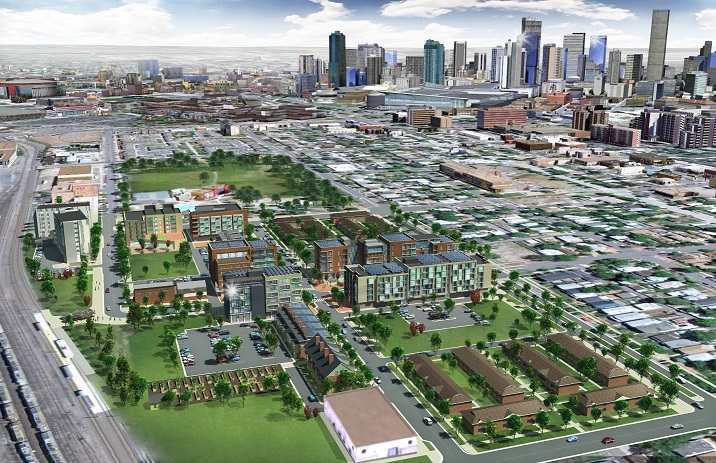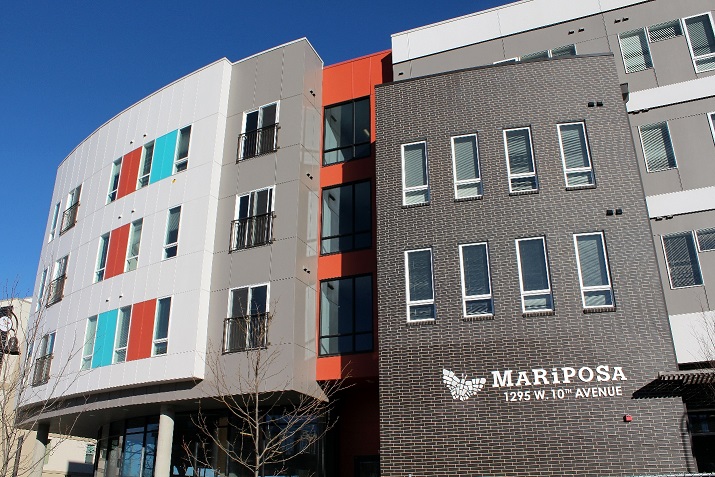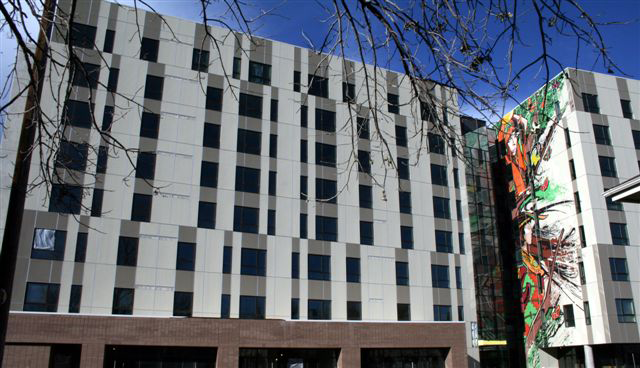Mariposa is located on the site of a former public housing project in Denver, Colorado. The project is a master planned development of a transit-oriented mixed-income housing, senior housing, retail, and common outdoor areas (e.g. playgrounds and gardens) that was led by the Denver Housing Authority (DHA). The development was planned to maximise the amount of residential, commercial and recreation space that is within roughly 15-minutes walking distance from public transportation. The re-development aimed to create a connected and healthy place through improved access to physical, economic, and social amenities. The goal of the master plan was to redevelop the area while preserving the positive qualities of the existing South Lincoln neighbourhood.
The DHA phased the redevelopment project over seven years to reduce the displacement of families, the elderly and disabled residents of the former public housing project. Before redevelopment, the 17.5-acre (7 hectares) Mariposa site was home to approximately 250 residents living in brick-clad apartments built in 1954. As of 2017, there were about 1,500 residents living in the same area. Of these 1,500 residents approximately 48 percent were returning residents, in comparison to the typical 10 to 15 percent for similar ‘raze and rebuild’ projects.(1)
This project is featured as one of our healthy urban development case studies and this case study was written by Elizabeth Cooper.
| Location | Denver, Colorado, USA |
| Project type: | Mixed-use, residential |
| Site size: | 7 hectares (17.5 acres) |
| Project size: | 800-900 mixed-income housing units, 100 senior housing units, mixed-use retail spaces, and diverse outdoor living spaces, playgrounds and garden |
| Goals: | To create a connected and healthy place |
| Date started: | 2009 |
| Date completed: | 2017 |
| Project cost: | USD 197 million |
| Website: | http://www.mariposadenver.com/ |
| Stakeholders: | Developer: Denver Housing Authority (DHA), Planner: Mithun, Impact Assessment: Envirohealth Consulting, Architect: Shears Adkins Rockmore, Health consultant: Colorado Health Foundation |
Health and wellbeing
From the beginning, the intention of Mariposa’s developers was to create a community that supported and enhanced the health of the residents, and to that end the DHA and other stakeholders developed the Mariposa Healthy Living Initiative (HLI). The initiative was largely adapted from the Healthy Development Measurement Tool (HDMT) developed by the San Francisco Department of Public Health.(2)
The HLI includes three core initiatives:
- Campaigns for Action
- Assessment and Indicators
- The Mariposa Healthy Living Toolkit.
The health and wellbeing design and planning strategies are numerous, and are fully described in the Mariposa Healthy Living Toolkit.(3) A summary of some of the measures is included below, as they relate to the scales of health impact and core principles of the THRIVES framework.(4)
| Planetary health | Integrated district level energy strategies that incorporate resource conservation programs and on-site renewable energy generation. Specifically, high performance building envelopes, ENERGY STAR building standards and high efficiency heating and cooling systems were designed to reduce energy consumption by 40%, benefitting the residents and DHA. On-site, two-megawatt photovoltaic solar panel system planned to offset up to 80% of the projected energy needs. |
| Ecosystem health | Commitment to providing access to public transport, and improved pedestrian and cycling routes that reduce personal car use and encourage active travel. Strategies for achieving these goals include new tree plantings, wider sidewalks, and dedicated bicycle lanes. Advanced storm water management system was also incorporated into the new street and site design. |
| Local health | Increased the range and quality of locally available services, such as open green spaces, healthcare clinic, educational programmes for all ages, and access to jobs and job training. Improved access to locally grown foods and encourage healthy eating habits. Specific campaigns for the Healthy Places initiative include a new recreation centre (with fitness centre), numerous classes, and an outdoor pool; new playground and sports facilities at Lincoln Park; a community plaza with children’s play structure and a pergola; and the Tapiz Garden which is open to all residents to grow their own food. |
| Inclusion | Inclusivity was recognised in the master plan summary with goals of providing amenities and site features to meet the needs of different ages and cultures. To this end, the designers and planners created early and frequent opportunities for residents to engage in the design process. The redevelopment master plan proposes new residential units in a mix of townhomes and multi-family flats to provide a diversity of housing types and costs. Dedicated housing was provided for the elderly and disabled communities, and programmes were designed to increase engagement by diverse participants. |
| Equity | Mariposa considered equity in income and wealth recognising that the relationship between income and health is mediated through factors such as employment conditions, housing adequacy, community violence and environmental quality. |
| Sustainability | Environmental stewardship was a core element of the Mariposa masterplan. Five primary objectives and indicators were identified in the plan: decrease energy consumption, repair and protect natural areas, improve access to sustainable agriculture, preserve air quality, and maintain low levels of noise pollution. |



The Denver Housing Authority produced a video (below) about the groundbreaking for the rebuild of South Lincoln Homes into Mariposa. The video describes the sustainability and healthy living initiatives and gives residents’ perspectives on the project.
Achievements
The Mariposa Healthy Living tool was developed and used as a new planning tool. Denver Housing Authority conducted annual surveys open to all residents to assess the development. The project has been evaluated and positive trends were identified in many indicators of a healthy community, for example:
- Total crime rate dropped from 246 per 1,000 people to 157 (per 1,000 people) between 2005 and 2011 for the La Alma/ Lincoln Park and Auraria neighbourhoods.(5)
- Average transit commute time dropped from 24 minutes in 2010 to 20 minutes in 2012 for the La Alma/ Lincoln Park neighbourhood, as compared to 27 minutes in 2010 or 25 minutes in 2012 citywide.(5)
- Percentage of residents with access to open space and nature within a half mile (0.8 km) of their homes increased from 26 to 32 percent.(6)
- Number of healthy food outlets within a half mile increased from 0 to 1.(7)
- Greater understanding of how to navigate the health system.
- By 2012, after the first phases of redevelopment, 38 percent of residents said their health had improved, and smoking rates dropped 6 percent.(8)
- Fewer residents using hospital emergency departments as primary care and fewer 911 calls.(7)
- The Mariposa District redevelopment was awarded the U.S. Environmental Protection Agency’s 2012 National Award for Smart Growth Achievement in the Equitable Development Category. This award is given for “creative, sustainable initiatives that help protect the health and the environment of communities while also strengthening local economies”.(9)
Lessons learned
This case study provides valuable lessons about addressing health comprehensively as part of the initial and ongoing redevelopment of public housing and the creation of mixed-income communities:
- Health outcomes should be defined early and be widely supported and operational.
- Establishing comprehensive and achievable conditions that contribute to health and wellbeing is important for project planning and delivery.
- Early and sustained input from residents is critical for a health and wellbeing agenda.
- Tracking progress is challenging and continued assessments and evaluations is important.
More information
- Douglas, E., 2017. Denver’s Mariposa District leads charge in changing the face of public housing. The Denver Post.
- Mithun, 2010. Use of the Healthy Development Measurement Tool (HDMT) in Denver: Cross-Sector Partnerships for Development and Public Health, in: May 2010 Denver HDMT Final Report. Mithun, Seattle, WA.
- Mithun Inc., Denver Housing Authority, 2012. Mariposa Healthy Living Toolkit. Mithun Inc., Seattle, WA.
- Pineo, H., 2020. Towards healthy urbanism: inclusive, equitable and sustainable (THRIVES) – an urban design and planning framework from theory to praxis. Cities Health 0, 1–19. https://doi.org/10.1080/23748834.2020.1769527
- Christensen, E., Runge, C., Crangle, K., Picard, L., Powers, S., Fulenwider, D., 2012. The Mariposa Healthy Living Initiative.
- Kramer, A., Lassar, T.J., Federman, M., Hammerschmidt, S., 2014. Building for Wellness: The Business Case. Urban Land Institute, Washington DC.
- Joseph, M., 2019. Mixed-Income Communities as a Strategic Lever to Impact Health Equity: Lessons from the Field and Implications for Strategy and Investment.
- Global Wellness Institute, 2018. Build Well to Live Well: Wellness Lifestyle Real Estate and Communities.
- United States Environmental Protection Agency, 2012. EPA recognizes Denver’s Mariposa District for Smart Growth achievement. Available from: https://archive.epa.gov/epapages/newsroom_archive/newsreleases/1302b6a2a8733a1685257acb00660770.html (accessed 4.6.22).
